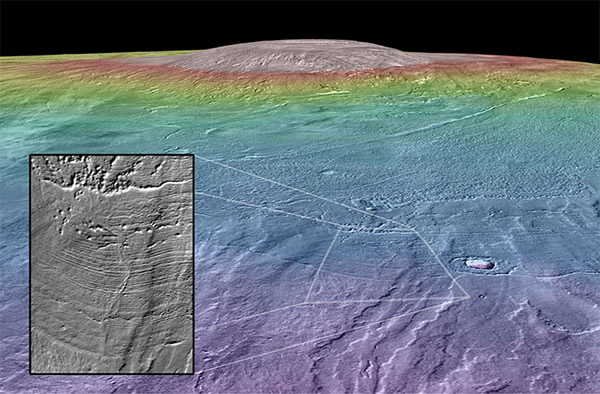Could a Mars Volcano be an Oasis for Life?
Braided fluvial channels (inset) emerge from the edge of glacial deposits roughly 210 million years old on the martian volcano Arsia Mons, nearly twice as high as Mount Everest.
In our continuing fascination for Mars and its past habitable potential, scientists are now focusing on a possible red planet oasis for microbial life where liquid water may have been stored underground and heated by a volcano.
Geologists from Brown University have studied this fascinating possibility by focusing on Arsia Mons, a 10 mile (16 kilometer) high ancient shield volcano that likely erupted during the Martian glacial period, melting surrounding glaciers and creating englacial lakes at the bottom of the volcano’s slopes. Their research has been published in the journal Icarus.
Through analysis of data from NASA’s Mars Reconnaissance Orbiter, the researchers were able to identify features that were likely formed when the volcano erupted around 210 million years ago when glaciers were present. The heating from the eruption may have melted portions of the glaciers, trapping ‘bubbles’ of liquid water inside their glacial cocoons for long periods of time.
As the logic goes, where there’s liquid water (and therefore heat), life may have thrived. And what makes Arsia Mons really interesting is that this liquid water likely existed on the Martian surface in the relatively recent geologic past, potentially making this region a key target for future Mars life-hunting missions. NASA’s Curiosity and Opportunity rovers are currently exploring regions that formed billions of years ago, the features around Arsia Mons formed millions of years ago.
“If signs of past life are ever found at those older sites (where Curiosity and Opportunity are exploring), then Arsia Mons would be the next place I would want to go,” said lead researcher Kat Scanlon, Brown University graduate student.
The slopes of Arsia Mons have long been of interest to geologists who speculated that there were likely large bodies of ice present during volcanic activity. In 2003, Jim Head (also of Brown University) and David Marchant (Boston University) identified landforms around Arsia Mons that resembled the features left by receding glaciers in the Dry Valleys of Antarctica.
As glaciers recede on Earth, piles of rubble build up at the front of the ice, leaving a rocky ridge as a geological record of the past location of the glacier.
New models of Mars’ climatic past also support the theory that glaciers may have been present in this equatorial location and studies of ancient lava flows appear to coincide around 210 million years ago. According to this research, all these factors could have supported liquid water englacial lakes for hundreds to thousands of years, possibly enough time for very basic lifeforms to evolve.
“There’s been a lot of work on Earth — though not as much as we would like — on the types of microbes that live in these englacial lakes,” said Scanlon. “They’ve been studied mainly as an analog to [Jupiter’s moon] Europa, where you’ve got an entire planet that’s an ice covered lake.”
What’s more, sub surface masses of ice and pockets of liquid water may persist in the region today, only boosting the region’s candidacy for a directed life-hunting Mars mission.(May 29, 2014 03:14 PM ET // by Ian O'Neill)












